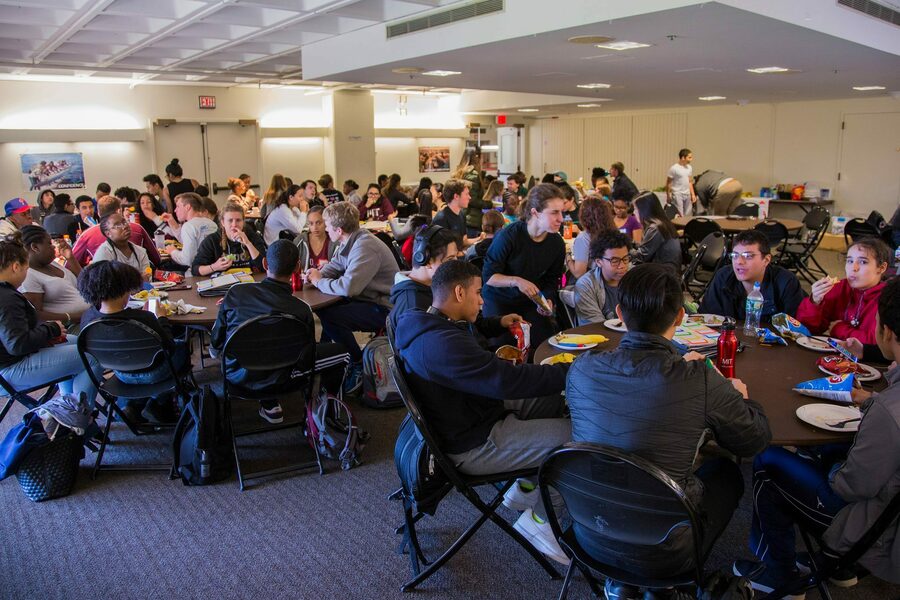Amphibious Achievement

Locations
- Amphibious Achievement - Massachusetts Institute of Technology (MIT), Massachusetts
Focus Area
- Education
Students, called Achievers in the program, learn how to translate the grit, discipline, and confidence taught in athletics into the classroom, and are equipped with the mentorship and skills necessary to graduate high school and succeed beyond it.
The Issue
Over the past twenty years, the racial achievement gap in the US has remained unchanged — Black high school students continue to lag behind white students by over 0.75 standard deviations on standardized tests. This is roughly the difference between the performance of an average 4th grader and the performance of an average 8th grader. The socioeconomic achievement gap between those in the top and bottom quartiles similarly hovers around 0.8 standard deviations, and it has remained largely unchanged over the past 50 years.
Like most urban school districts, the Boston Public School (BPS) system exemplifies the academic achievement gap. As of 2014, BPS students score 17% below the state average on the Massachusetts Comprehensive Assessment System (MCAS). Furthermore, average school graduation rates are 66% compared to state and national averages of 85% and 78%, respectively.
Many students who attend Boston public schools are traditionally disadvantaged. According to BPS data, 34% of its students are African American, 42% are Hispanic/Latino, and 66% are economically disadvantaged. One in three BPS students today is an English learner, and 75% are designated as “high-need.” To close the achievement gap, “high-need” students require additional support.
Achievement gap progress in Boston has plateaued in recent years. For example, a 2017 study found eighth-grade math scores had fallen by 3 points between 2012-2017, despite growth the previous 20 years. These students enter high school at an academic disadvantage and are unprepared to excel in higher-level classes. The pandemic worsened academic achievement, as BPS students lost 85% of a year of math education.
The stubborn endurance of academic achievement inequalities calls for new solutions. Despite limited progress, two approaches show promise: tutoring has been shown to improve cognitive skills and non-cognitive skills have been linked to educational benefits. Instruction inside and outside of the classroom is essential to promoting student growth.
However, few programs combine both approaches. Pathways out of poverty often depend on educational achievement — a high school diploma, bachelor’s degree, or speciality certification. Helping students meet their educational goals has a direct impact on their quality of life down the road. But, more evidence is needed to understand how innovative programs can support students.
The Intervention
Amphibious Achievement is a mentorship program based at the Massachusetts Institute of Technology (MIT) that offers athletics and academics to BPS high school students.
Every Sunday, the high school students, known as Achievers, arrive on MIT’s campus and meet with their volunteer college mentors. The mentors provide two hours of athletics instruction in either swimming or rowing—sports which are inaccessible to most urban public school students. Then, the students have lunch together before beginning academic tutoring in small groups. Academic instruction can include homework help, college application advice, or a curiosity-driven STEM lesson.
The athletics portion draws participants who might otherwise steer clear of a tutoring program but who stand to benefit the most from the extra academic support. The program was founded by MIT student athletes who saw the benefits that athletics can have on academic and personal success. Amphibious Achievement’s goal, expressed by the tagline, is to promote student success in and out of the water.
Research Question
What is the effect of pairing academic and athletic mentorship on high school achievement and labor market outcomes for urban public school students?
Intended Outcomes
- Students who participate in the Amphibious Achievement program will have higher grade point averages in high school and higher rates of high school completion.
- Achievers will be more likely to enroll in college and graduate with a degree than non-Achievers. Early-life labor market outcomes, including occupation and employment, will also be improved for Achievers.
Research Study Design
The Amphibious Achievement project is a retrospective, randomized evaluation.
Amphibious Achievement serves roughly 25 students a year; but most years, more than 25 students sign up for the program. Students are recruited to the program through information sessions at Boston public schools, referrals from teachers and school administrators, and by word-of-mouth. To deal with the oversubscription problem, Amphibious Achievement runs a lottery to randomly select students to participate. Randomization is the most fair way to determine admission when the program is oversubscribed.
In 2014, researchers at MIT ran a pilot study with 100 applicants at three Boston public schools. The study found that students who were randomly offered the opportunity to enroll in the program observed a 0.6 standard deviation increase in their GPA, moving from a C+ to B average. This increase is equivalent to a 60% reduction in the racial achievement gap.
LEO researchers are expanding the pilot study to analyze data from 2011 to 2022. An estimated 200 students from 10 Boston Public Schools participated in Amphibious Achievement during this time period. Using data from the Massachusetts Department for Elementary and Secondary Education and the National Student Clearinghouse, LEO researchers will compare high school and labor market outcomes between the control and treatment groups.